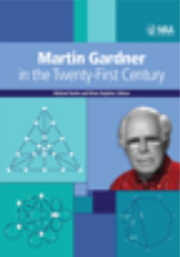Book contents
- Frontmatter
- Preface
- Contents
- I Geometry
- II Number Theory and Graph Theory
- III Flexagons and Catalan Numbers
- IV Making Things Fit
- V Further Puzzles and Games
- VI Cards and Probability
- 30 Modeling Mathematics with Playing Cards
- 31 The Probability an Amazing Card Trick Is Dull
- 32 The Monty Hall Problem, Reconsidered
- 33 The Secretary Problem from the Applicant's Point of View
- 34 Lake Wobegon Dice
- 35 Martin Gardner's Mistake
- VII Other Aspects of Martin Gardner
- Index
- About the Editors
31 - The Probability an Amazing Card Trick Is Dull
from VI - Cards and Probability
- Frontmatter
- Preface
- Contents
- I Geometry
- II Number Theory and Graph Theory
- III Flexagons and Catalan Numbers
- IV Making Things Fit
- V Further Puzzles and Games
- VI Cards and Probability
- 30 Modeling Mathematics with Playing Cards
- 31 The Probability an Amazing Card Trick Is Dull
- 32 The Monty Hall Problem, Reconsidered
- 33 The Secretary Problem from the Applicant's Point of View
- 34 Lake Wobegon Dice
- 35 Martin Gardner's Mistake
- VII Other Aspects of Martin Gardner
- Index
- About the Editors
Summary
The Ashland University student chapter of the MAA holds biweekly meetings, typically consisting of a short business meeting to plan activities that the group is sponsoring followed by a social time when the group plays mathematical games and munches on brownies. As a new feature in Fall 2002, I told the students that I would perform a new mathematical card trick at each of these meetings. My source for most of these card tricks is the delightful book [2]. One of the finest tricks described there is due to an amateur New York magician named Henry Christ. A spectator shuffles a deck of cards several times, and then the magician deals nine cards face down on a table. The spectator selects one of these cards, looks at it, and stacks the nine dealt cards on the table with the selected card on top. The magician places this stack on the bottom of the deck, and hands the deck to the spectator. The spectator is told to deal the cards out face up in a pile, counting backwards out loud from ten while dealing the cards. If at some point, the denomination of the card matches the number the spectator says, then the spectator repeats this procedure with a second pile, again counting backwards from ten. If 1 is reached without any cards matching, the spectator places the next card face down on top of the pile, and repeats this procedure with the second pile.
- Type
- Chapter
- Information
- Martin Gardner in the Twenty-First Century , pp. 227 - 230Publisher: Mathematical Association of AmericaPrint publication year: 2012



